
The LGM-30 Minuteman is a U.S. land-based intercontinental ballistic missile (ICBM), in service with the Air Force Global Strike Command. As of 2019, the LGM-30G Minuteman III version is the only land-based ICBM in service in the United States and represents the land leg of the U.S. nuclear triad, along with the Trident submarine-launched ballistic missile (SLBM) and nuclear weapons carried by long-range strategic bombers.

Vandenberg Air Force Base is a United States Air Force Base located 9.2 miles (14.8 km) northwest of Lompoc, California. The installation falls under the jurisdiction of the 30th Space Wing, United States Space Force (USSF).
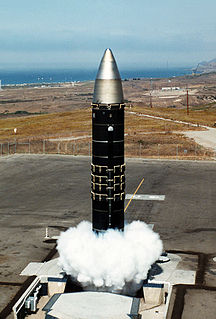
The LGM-118A Peacekeeper, first known as the M-X or "Missile-X", was an encapsulated ICBM and the first U.S. ICBM to use a Cold Launch System. Although larger than the LGM-30 MMIII, the M-X was designed to fit inside existing hardened LGM-30 Minuteman III ICBM silos as a silo-based ICBM and later as a mobile ICBM via the Peacekeeper Rail Garrison. The first 50 M-X ICBMs were scheduled to be deployed and full initial operational capability achieved by the United States beginning and ending in 1986. The M-X Peacekeeper was a MIRV missile platform that could carry up to 12 re-entry vehicles, each armed with a 300-kiloton W87 warhead in a Mk.21 reentry vehicle (RV). The first 50 missiles were deployed starting in 1986, after a long and contentious development program that traced its roots into the 1960s with the first generation ICBMs. Initial LGM-118A missile testing began 1971, with full-scale development starting in 1974. The first flight test occurred in 1983. This test also included the successful test deployment of six inert (unarmed) Re-entry vehicles, each hitting pre-planned targets. Initially, 100 M-X ICBMs were planned to be built and deployed, but Congressional and budgetary concerns eliminated the final procurement.

The RT-2PM Topol is a mobile intercontinental ballistic missile designed in the Soviet Union and in service with Russia's Strategic Missile Troops. By the early 2020s, all SS-25 ICBMs will be replaced by versions of Topol-M.

A launch control center (LCC), in the United States, is the main control facility for intercontinental ballistic missiles (ICBMs). A launch control center monitors and controls missile launch facilities. From a launch control center, the missile combat crew can monitor the complex, launch the missile, or relax in the living quarters. The LCC is designed to provide maximum protection for the missile combat crew and equipment vital to missile launch. Missile silos are common across the midwestern United States, and over 450 missiles remain in US Air Force (USAF) service.
Command Data Buffer (CDB) was a system used by the United States Air Force's Minuteman ICBM force. CDB was a method to transfer targeting information from a Minuteman Launch Control Center to an individual missile by communications lines. Prior to CDB, new missile guidance would have to be physically loaded at the launch facility; the process usually took hours.
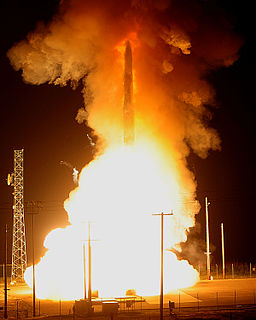
The 564th Missile Squadron is an inactive United States Air Force unit. It was last assigned to the 341st Operations Group, stationed at Malmstrom Air Force Base, Montana.

The mission of the 625th Strategic Operations Squadron (STOS) is to execute and support global strike through continuous, rapid, accurate and survivable nuclear operations. The 625th STOS has five flights that play different roles in this mission. The Latin motto of the 625th STOS is Si vis pacem para bellum, which means, "If you wish for peace, prepare for war."
The AN/FRC-117 Survivable Low Frequency Communications System (SLFCS) was a communications system designed to be able to operate, albeit at low data transfer rates, during and after a nuclear attack. The system used both very low frequency (VLF), and low frequency (LF) radio bands.

The 490th Missile Squadron is a United States Air Force unit. It is assigned to the 341st Operations Group, stationed at Malmstrom AFB, Montana. The 490 MS is equipped with the LGM-30G Minuteman III Intercontinental ballistic missile, with a mission of nuclear deterrence.
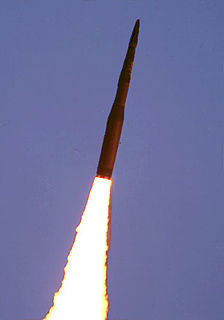
The 68th Missile Squadron is an inactive United States Air Force unit. It was last assigned to the 44th Operations Group, stationed at Ellsworth AFB, South Dakota.

The Airborne Launch Control System (ALCS) provides a survivable launch capability for the United States Air Force's LGM-30G Minuteman III intercontinental ballistic missile (ICBM) force. The ALCS is operated by airborne missileers from Air Force Global Strike Command's (AFGSC) 625th Strategic Operations Squadron (STOS) and United States Strategic Command (USSTRATCOM). The weapon system is located on board the United States Navy's E-6B Mercury, which serves as USSTRATCOM's "Looking Glass" Airborne Command Post (ABNCP). The ALCS crew is integrated into the ABNCP battle staff and is on alert around-the-clock.
This is a chronology of the LGM-30 Minuteman intercontinental ballistic missile, acquisition and operational.
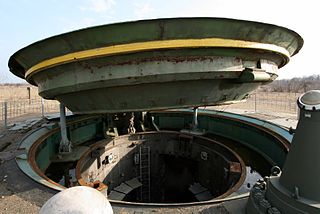
A missile launch facility, also known as an underground missile silo, launch facility (LF), or nuclear silo, is a vertical cylindrical structure constructed underground, for the storage and launching of intercontinental ballistic missiles (ICBMs).
A missile combat crew (MCC), is a team of highly trained specialists, often called missileers, manning Intermediate Range and Intercontinental ballistic missile systems. In the United States, men and women, officially coded as Nuclear and Missile Operations Officers, of the United States Air Force, operate underground missile systems at launch control centers located throughout the country. There are also a select few missileers that have the chance to become part of a Missile Combat Crew-Airborne (MCC-A) operating the Airborne Launch Control System which provides a survivable launch capability for the Minuteman ICBM force. Crew size varied among the different missile systems, but the number was always greater than one, to abide by USSTRATCOM's Two-man rule for positive control of nuclear weapons.
Simulated Electronic Launch Minuteman (SELM) is a method used by the United States Air Force to verify the reliability of the LGM-30 Minuteman intercontinental ballistic missile. SELM replaces key components at the Launch Control Center to allow a physical "keyturn" by missile combat crew members. This test allows end-to-end verification in the ICBM launch process.
Simulated Electronic Launch Peacekeeper (SELP) was a method used by the United States Air Force to verify the reliability of the LGM-118A Peacekeeper intercontinental ballistic missile.
The Improved Launch Control System was a system used by the United States Air Force's Minuteman II intercontinental ballistic missile force. The system was a method to transfer targeting information from a Minuteman launch control center to an individual missile by communications lines. Prior to the Improved Launch Control System, new missile guidance had to be loaded at the launch facility; the process usually took hours.
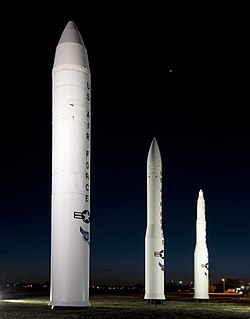
Warren AFB or redirects here. See Francis E. Warren at the link.











